Grand Majestic Galapagos Luxury Yacht
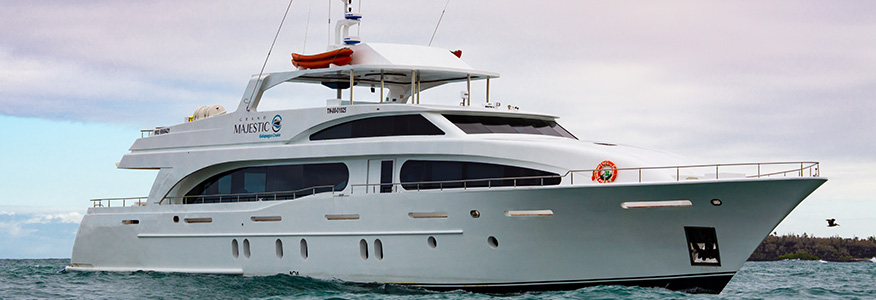
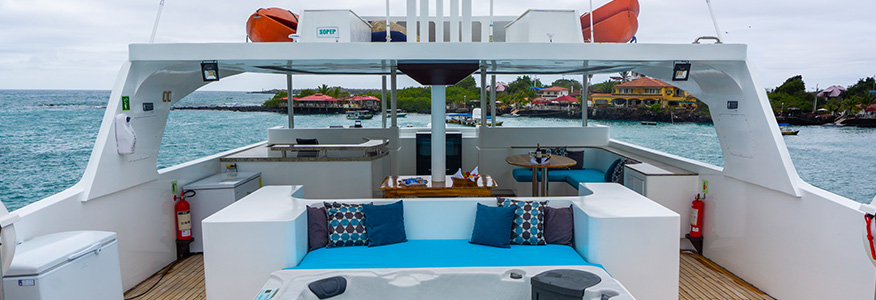
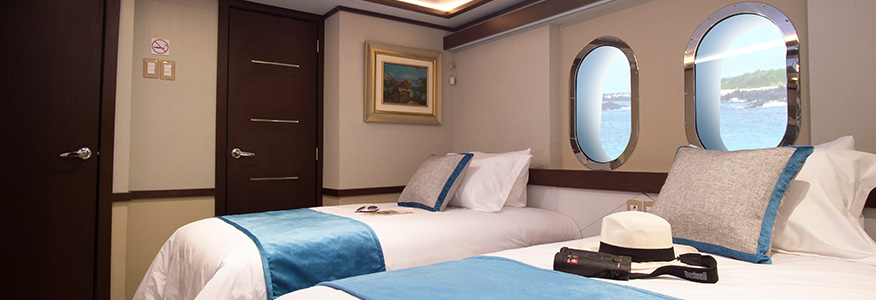
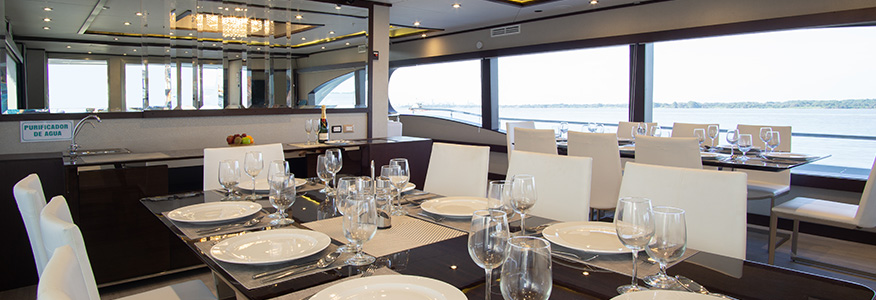
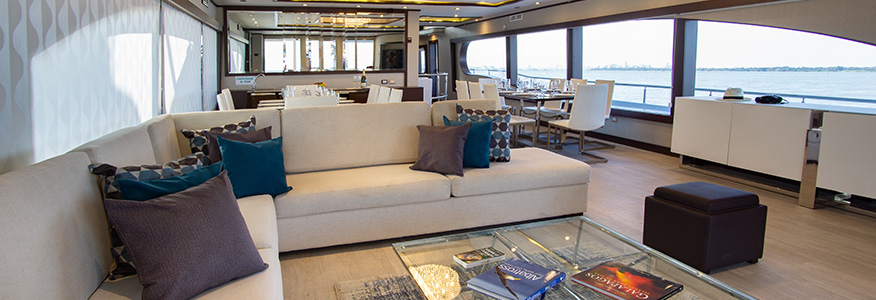
Grand Majestic Luxury Yacht
The M/Y Grand Majestic is one of the last yachts in entering the Galapagos islands this year. She is beautiful and elegant while she conserves a sporty style. The Grand Majestic has been conceived with the idea of providing luxury charter services in the Galapagos islands while she navigates among the most important sites of the Galapagos archipelago. Ideal for families or group of friends, this yacht is one of the best options to discover nature in a private fashion.
One of our hand-picked Naturalist Guides will be in charge of leading your expedition, he will be your liaison with the exuberant wildlife that you will find in the islands as he will be able to explain every single fact and move in the islands.
Our chef on board will your first introduction to a traditional and authentic Ecuadorian gastronomy but always keeping in mind the most important dishes of the international cuisine. We can also prepare our supplies for people with special diets such as vegetarians meals, kosher meals, gluten free meals and vegan meals. As Ecuador is centrally located in one of the richest tropical zones, our production of fresh organic fruits and vegetables is part of our daily diets.
The Grand Majestic is the fastest yacht in the Islands and offers high-quality service on board with a crew that has many years of experience in Galapagos. The yacht offers great comfort in one master suite and seven deluxe staterooms, ample social areas and a big sun deck where guests can enjoy the sun and the views of the islands.
- Day 1: Monday (San Cristóbal)
am
In the morning, you will arrive at San Cristobal Island. After going through immigration and baggage claim, you will be met by a Grand Majestic staff member and transferred to the yacht. You will be shown to your cabin where you will have some time to settle in before lunch and a welcome briefing.
pm
In the afternoon, your first visit takes you to El Junco Lagoon. Located in the highlands 19 kilometers from Puerto Baquerizo Moreno, El Junco is located in the caldera of an extinct volcano. Rainwater feeds the lagoon. There are many farms and ranches in this area of San Cristobal Island, and sometime cows can be found near the lagoon.
- Day 2: Tuesday (Floreana Island)
am
In the morning, you will visit the famous Post Office Bay. You will land on a beach and head to a spot where 18th century whalers placed a wooden barrel used as an unofficial mail box. The custom continues to this day with Galapagos visitors. So, don’t forget your postcards, and don’t be surprised if the post card arrives to its destination before you even get home!
pm
Your afternoon visit is to Cormorant Point. Here you will enjoy a hike to a salt-water lagoon which is home to flamingos. You will also have a chance to snorkel around Devil’s Crown which is the rocky remains of an offshore volcano sticking out of the water. This is a great location to spot a wide range of marine creatures.
- Day 3: Wednesday (Española Island)
am
In the morning, you will visit Suarez Point. On the trail you will have the chance to see blue-footed boobies, albatrosses, and Nazca boobies. This island is the breeding site of nearly all of the world’s 12,000 pairs of waved albatrosses. You will also visit a beautiful site on the ocean front where there is a cliff that the large albatrosses use as a launching pad! You will have the chance to see the famous blowhole that spurts sea water into the air. The landscape is great for photography.
pm
The afternoon excursion takes you to the spectacular Gardner Bay. After landing, you can walk across a lovely white-sand beach amongst a busy sea lion colony or dive into the water to swim with sea lion pups. You may also see curious mockingbirds on the beach.
- Day 4: Thursday (Santa Cruz Island)
am
In the morning, you will visit the Twin Craters located opposite to each other on both sides of the road leading from Puerto Ayora to Baltra. The name is only figurative; not real craters, these formations were created by the collapse of surface material in underground fissures and chambers. The view is breathtaking.
pm
In the afternoon, you will visit “Fausto Llerena” Giant Tortoises Creeding Center in Puerto Ayora, Santa Cruz Island, where giant tortoises are bred in captivity; this is home to tortoises ranging from 3-inches (new hatchlings) to 4-feet long adults. Subspecies of the giant tortoises interact with one another, and many of the older tortoises are accustomed to humans stretching out their heads for a photo opportunity. The babies are kept until they are about four years-old and strong enough to survive on their own.
- Day 5: Friday (Genovesa Island)
am
In the morning, you will visit El Barranco which is also known as Prince Phillip’s Steps. It is a steep, rocky path that leads up to a high cliff rock face. A marvelous view can be appreciated from here. This site is also home to a palo santo forest as well as red-footed boobies, short-eared lava owls, Galapagos swallows, and Galapagos doves.
pm
In the afternoon, you will visit the white-sand coral beach of Darwin Bay which heads a half mile trail (0,75km) that winds through mangroves filled with land birds. Nazca boobies, red-footed boobies, and swallow-tailed gulls can be spotted here. Further down the path we find tidal pools where sea lions swim playfully. At the end is a spectacular view of a cliff.
- Day 6: Saturday (Rabida and Chinese Hat)
am
In the morning, you will visit Rabida Island (or Jervis) which is one of the most colorful and volcanically varied islands in the archipelago as well as a great snorkeling site. We will start on Rabida’s famous maroon/red sand beach, and after an easy hike, you will arrive to a stunning lookout to enjoy the amazing landscapes. The island is a birdwatcher’s delight. Some species are abundant such as a few varieties of finches, Galapagos vermilion flycatchers, Galapagos hawks and brown pelicans.
pm
In the afternoon, you will visit Chinese Hat Islet. This small islet is located near the southeast coast of Santiago Island. Its name comes from the distinct shape of the islet’s summit. This small islet is a great location to view many geological formations such as lava tunnels and lava flows. Some of the lava flows were formed underwater and subsequently raised above sea level. The presence of coral heads on the lava flow indicates this phenomenon.
- Day 7: Sunday (San Cristobal Island)
am
In the morning, you will visit Witch Hill. Located on the northern coast, this eroded hill and its surroundings present one of the most picturesque beaches in the Galapagos with its white powdery sand and the abundance of animals. Wildlife includes sea turtles, rays, and various types of booby birds. The clear water provides an excellent opportunity for enjoying swimming and snorkeling.
pm
In the afternoon you will take part in an excursion to Lobos Island which means “Sea Lion Island.” This appropriately named island is ripe with noisy, playful, jolly sea lions who will welcome you to their home with open, well, fins. This island also offers great snorkeling opportunities as well as the chance to see blue- footed and Nazca boobies.
- Day 8: Monday (San Cristobal Island)
am
In the morning, you will visit the Interpretation Center. This site is part of an environment project. The tour of this center will explore the natural history of the islands including human interaction and conservation efforts. The Museum of Natural History explains the volcanic origin of the archipelago, ocean currents, climate, and the arrival of endemic species. The Human History exhibit chronologically describes significant events such as discovery and colonization of the islands.
After visiting the Interpretation Center, you will be transferred to the San Cristobal airport to catch your flight to Guayaquil or Quito on mainland Ecuador.
- Day 1: Monday (SAN CRISTOBAL ISLAND)
am
You will arrive at San Cristobal Island in the morning. After passing through immigration and baggage claim, you will be met by a Grand Majestic staff member and transferred to the yacht. You will be shown to your cabin where you will have some time to settle in before lunch and a welcome briefing.
pm
Breeding Center Jacinto Gordillo - “La Galapaguera”, in Cerro Colorado, is a new visitor site in the southeast part of San Cristobal Island and can now be reached in roughly one hour by road from Puerto Baquerizo Moreno. On the trees and shrubs surrounding the site, you may see land birds like warblers, finches and mockingbirds. Giant tortoises can be observed on the trails. They live there wild but in a protected area to ensure their survival by sealing them off from introduced predators like pigs and goats.
- Day2: Tuesday (NORTH SEYMOUR AND SANTA CRUZ ISLANDS N)
am
In North Seymour you may see Galapagos sea lions, blue-footed boobies, and magnificent frigate birds which are abundant on this island. North Seymour was formed by a series of submarine lava flows containing layers of sediment that were uplifted by tectonic activity. The island is characterized by its arid vegetation zone.
pm
Visit Black Turtle Cove in the northern part of Santa Cruz. This inlet is surrounded by mangroves and is only accessible by dinghy. The shallow cove is a haven for young marine life. Black-tip and white-tip reef sharks, sea turtles, and a variety of rays are often spotted here
- Day 3: Wednesday (BARTHOLOMEW AND SANTIAGO ISLANDS BARTHOLOMEW AND SANTIAGO ISLANDS)
am
You will head to Bartholomew Island where the famous Pinnacle Rock is found. Bartholomew consists of an extinct volcano with a variety of red, orange, black and even green volcanic formations. We will take a trail of stairs to the summit of the volcano (about 30 or 40 minutes) where you will enjoy one of the best views of the islands! You will also visit a small, beautiful beach surrounded by the only vegetation found on this barren island. The beach is perfect for snorkeling where you may even see and swim with Galapagos penguins.
pm
Egas Port, also known as James Bay, on Santiago Island is home to the curious Galapagos hawks and quick-footed Galapagos lava lizards. The trail leads to the coastline with gorgeous tide pools and grottos full of fauna. Here the Galapagos furseals bathe in the sun. This is also a great snorkeling site.
- Day 4: Thursday (ISABELA ISLAND)
am
In the morning, you will visit Tagus Cove on Isabela Island which is located across from Fernandina Island, near the Bolivar Channel dividing the two islands. This spot has been frequented by ships since the 1800s, using the area as an anchorage site. Trails winding by Lake Darwin up to a ridge display wonderful views.
pm
Urbina Bay is located at the base of Alcedo Volcano on the west coast between Tagus Cove and Elizabeth Bay. This area experienced a major uplift in 1954 causing the land to rise over 16 feet. The coast expanded half a mile out leaving marine life stranded on the new shore. This area is also a great place for snorkeling.
- Day 5: Friday (FERNANDINA AND ISABELA ISLANDS FERNANDINA AND ISABELA ISLANDS)
am
Crossing the Bolivar Channel that divides Isabela and Fernandina Islands, you will land at Espinoza Point, and after walking past a colony of marine iguanas and a group of sea lions, you will reach the island’s highlight: the flightless cormorant nesting site. This area also provides a great opportunity to see the Galapagos hawk.
pm
Comprised of two separate coves, Vicente Roca Point is a large bay with spectacular sea life. Keep an eye out for seahorses, sea turtles, and the strange yet fascinating Mola mola (or sun fish) while you snorkel.
- Day 6: Saturday (SANTIAGO ISLAND)
am
In Espumilla Beach marine iguanas lounge and the Sally Lightfoot crabs attract the hunting herons performing the dance of predator and prey right before your eyes. Snorkeling is highly recommended as you could come face to face with an octopus, moray eel, shark and a variety of other species of tropical fish.
pm
You will visit Sullivan Bay located on the southeast part of Santiago. This place is interesting for its geology because the area is covered by lava flows. This place has elevations in the form of small volcanoes formed by the lava flows.
- Day 7: Sunday (SANTA CRUZ ISLAND)
am
Bachas Beach is located on the north shore of Santa Cruz and is a beach for swimming. One of the few remnants of the U.S. World War II presence in the Galapagos, a floating pier, can be seen here. You may see flamingos, Sally Lightfoot crabs, hermit crabs, black-necked stilts, and whimbrels. Sea turtles also nest on the beach.
pm
You will visit “Fausto Llerena” Giant Tortoises Creeding Center in Puerto Ayora, Santa Cruz Island, where giant tortoises are bred in captivity; this is home to tortoises ranging from 3-inches (new hatchlings) to 4-feet long adults. Subspecies of the giant tortoises interact with one another, and many of the older tortoises are accustomed to humans stretching out their heads for a photo opportunity. The babies are kept until they are about four years-old and strong enough to survive on their own.
- Day 8: Monday (SAN CRISTOBAL ISLAND)
am
This striking rock formation is located a couple hours off the western shore of San Cristobal. Jutting out of the water, the rocks stand vertically at hundreds of feet above the ocean divided by a small channel. Although there are no landing areas, kayaking and snorkeling allow visitors to spot a variety of marine life.
After this final visit, you will be transferred to the San Cristobal airport in time for your flight back to the mainland.
- Day 1: Thursday (Santa Cruz Island)
am
You will arrive at Baltra Island in the morning. After going through immigration and baggage claim, you will be met by a Grand Majestic staff member and transferred to the yacht. You will be shown to your cabin where you will have some time to settle in before lunch and a welcome briefing.
pm
In the afternoon, you will visit “Fausto Llerena” Giant Tortoises Creeding Center in Puerto Ayora, Santa Cruz Island, where giant tortoises are bred in captivity; this is home to tortoises ranging from 3-inches (new hatchlings) to 4-feet long adults. Subspecies of the giant tortoises interact with one another, and many of the older tortoises are accustomed to humans stretching out their heads for a photo opportunity. The babies are kept until they are about four years-old and strong enough to survive on their own.
- Day 2: Friday (Genovesa Island)
am
In the morning, you will visit El Barranco which is also known as Prince Phillip’s Steps. It is a steep, rocky path that leads up to a high cliff rock face. A marvelous view can be appreciated from here. This site is also home to a palo santo forest as well as red-footed boobies, short-eared lava owls, Galapagos swallows, and Galapagos doves.
pm
In the afternoon, you will visit the white-sand coral beach of Darwin Bay which heads a half mile trail (0,75km) that winds through mangroves filled with land birds. Nazca boobies, red-footed boobies, and swallow-tailed gulls can be spotted here. Further down the path we find tidal pools where sea lions swim playfully. At the end is a spectacular view of a cliff.
- Day 3: Saturday (Rabida and Chinese Hat)
am
In the morning, you will visit Rabida Island (or Jervis) which is one of the most colorful and volcanically varied islands in the archipelago as well as a great snorkeling site. We will start on Rabida’s famous maroon/red sand beach, and after an easy hike, you will arrive to a stunning lookout to enjoy the amazing landscapes. The island is a birdwatcher’s delight. Some species are abundant such as a few varieties of finches, Galapagos vermilion flycatchers, Galapagos hawks and brown pelicans.
pm
In the afternoon, you will visit Chinese Hat Islet. This small islet is located near the southeast coast of Santiago Island. Its name comes from the distinct shape of the islet’s summit. This small islet is a great location to view many geological formations such as lava tunnels and lava flows. Some of the lava flows were formed underwater and subsequently raised above sea level. The presence of coral heads on the lava flow indicates this phenomenon.
- Day 4: Sunday (San Cristobal Island)
am
In the morning, you will visit Witch Hill. Located on the northern coast, this eroded hill and its surroundings present one of the most picturesque beaches in the Galapagos with its white powdery sand and the abundance of animals. Wildlife includes sea turtles, rays, and various types of booby birds. The clear water provides an excellent opportunity for enjoying swimming and snorkeling.
pm
In the afternoon you will take part in an excursion to Lobos Island which means “Sea Lion Island.” This appropriately named island is ripe with noisy, playful, jolly sea lions who will welcome you to their home with open, well, fins. This island also offers great snorkeling opportunities as well as the chance to see blue- footed and Nazca boobies.
- Day 5: Monday (San Cristobal Island)
am
In the morning, you will visit the Interpretation Center. This site is part of an environment project. The tour of this center will explore the natural history of the islands including human interaction and conservation efforts. The Museum of Natural History explains the volcanic origin of the archipelago, ocean currents, climate, and the arrival of endemic species. The Human History exhibit chronologically describes significant events such as discovery and colonization of the islands.
pm
After visiting the Interpretation Center, you will be transferred to the San Cristobal airport to catch your flight to Guayaquil or Quito on mainland Ecuador.
- Day 1: Monday (San Cristobal Island)
am
In the morning, you will arrive at San Cristobal Island. After going through immigration and baggage claim, you will be met by a Grand Majestic staff member and transferred to the yacht. You will be shown to your cabin where you will have some time to settle in before lunch and a welcome briefing.
pm
In the afternoon, your first visit takes you to El Junco Lagoon. Located in the highlands 19 kilometers from Puerto Baquerizo Moreno, El Junco is located in the caldera of an extinct volcano. Rainwater feeds the lagoon. There are many farms and ranches in this area of San Cristobal Island, and sometime cows can be found near the lagoon.
- Day 2: Tuesday (Floreana Island)
am
In the morning, you will visit the famous Post Office Bay. You will land on a beach and head to a spot where 18th century whalers placed a wooden barrel used as an unofficial mail box. The custom continues to this day with Galapagos visitors. So, don’t forget your postcards, and don’t be surprised if the post card arrives to its destination before you even get home!
pm
Your afternoon visit is to Cormorant Point. Here you will enjoy a hike to a salt-water lagoon which is home to flamingos. You will also have a chance to snorkel around Devil’s Crown which is the rocky remains of an offshore volcano sticking out of the water. This is a great location to spot a wide range of marine creatures.
- Day 3: Wednesday (Española Island)
am
In the morning, you will visit Suarez Point. On the trail you will have the chance to see blue-footed boobies, albatrosses, and Nazca boobies. This island is the breeding site of nearly all of the world’s 12,000 pairs of waved albatrosses. You will also visit a beautiful site on the ocean front where there is a cliff that the large albatrosses use as a launching pad! You will have the chance to see the famous blowhole that spurts sea water into the air. The landscape is great for photography.
pm
The afternoon excursion takes you to the spectacular Gardner Bay. After landing, you can walk across a lovely white-sand beach amongst a busy sea lion colony or dive into the water to swim with sea lion pups. You may also see curious mockingbirds on the beach.
- Day 4: Thursday (Santa Cruz Island)
am
In the morning, you will visit the Twin Craters located opposite to each other on both sides of the road leading from Puerto Ayora to Baltra. The name is only figurative; not real craters, these formations were created by the collapse of surface material in underground fissures and chambers. The view is breathtaking.
pm
After visiting the Twin Craters, you will be transferred to the Baltra airport to catch your flight to Guayaquil or Quito on mainland Ecuador.
| CHARTER RATES | 8 DAYS |
5 DAYS |
4 DAYS |
|---|---|---|---|
| Regular Charter |
US$ 89,950 |
US$ 53,651 |
US$ 41,490 |
| High Season Charter* | US$ 99,950 |
US$ 59,615 |
US$ 46,103 |
| Christmas and New Year Charter** | US$ 129,950 |
N/A |
N/A |
| RATES PER PERSON | 8 DAYS |
5 DAYS |
4 DAYS |
|---|---|---|---|
| Master Suite |
US$ 7,945 |
US$ 4,745 |
US$ 3,645 |
| Stateroom | US$ 5,945 |
US$ 3,545 |
US$ 2,745 |
Lower Deck
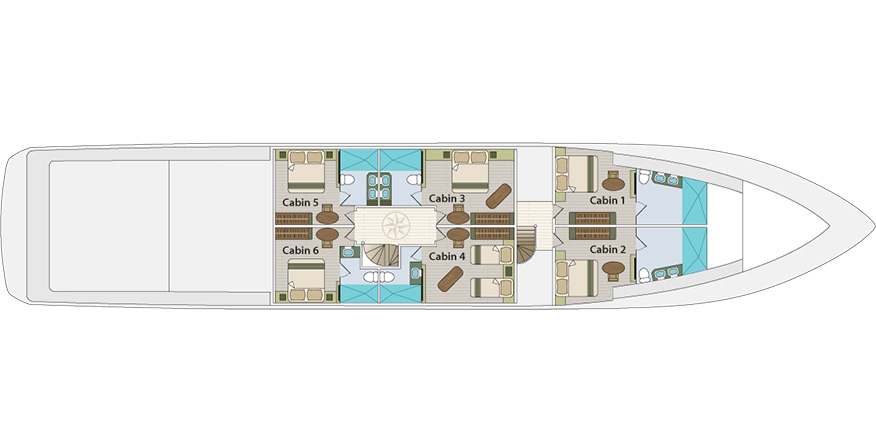
Main Deck
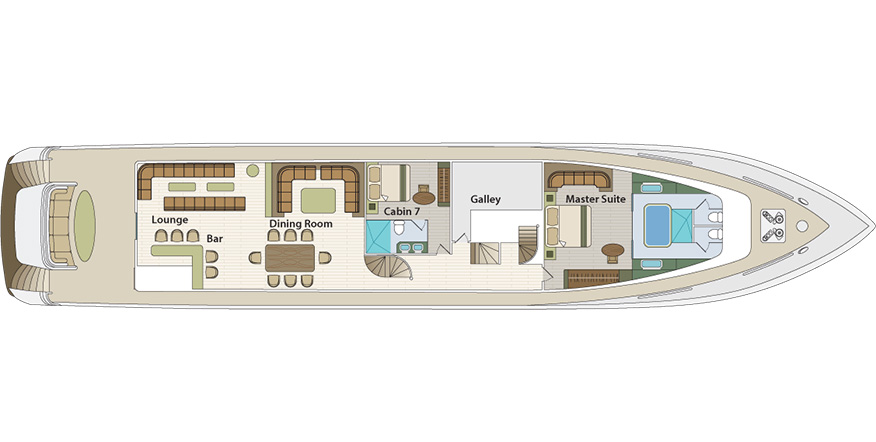
Sun Deck
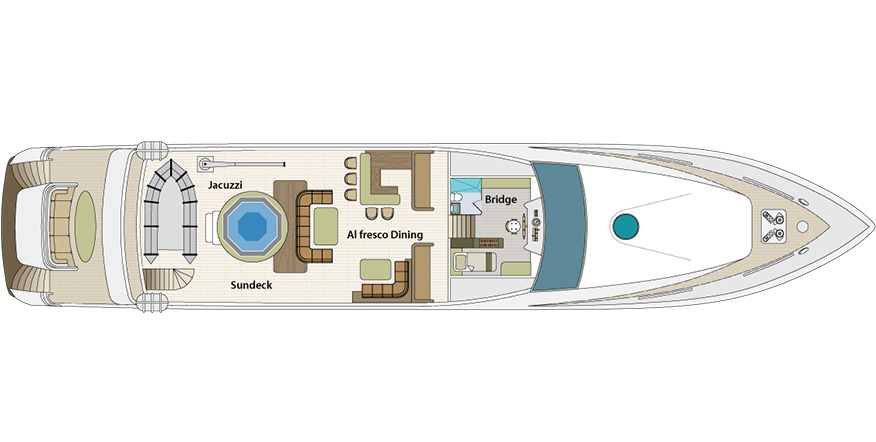
Specifications
| Year of construction: |
|
| Type: |
|
| Length: |
|
| Beam: |
|
| Draft: |
|
| Cruising Speed: |
|
| Capacity: |
|
| Main engines: |
|
| Water maker: |
|
| Exterior: |
|
| Accommodation: |
|


